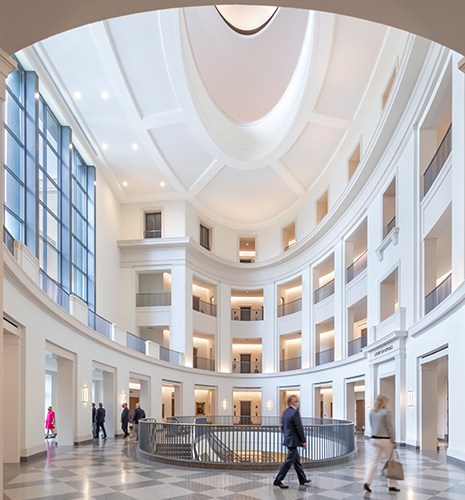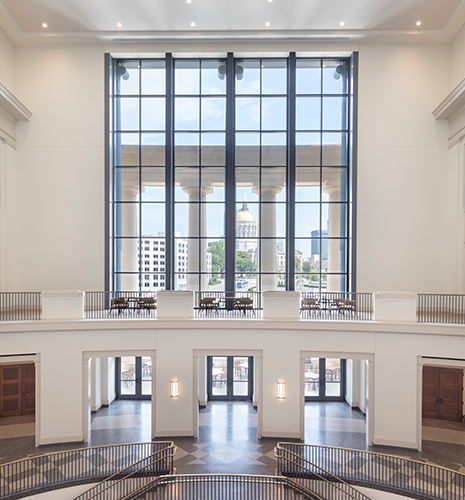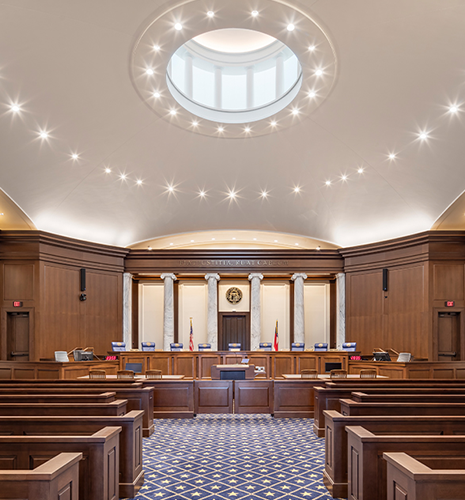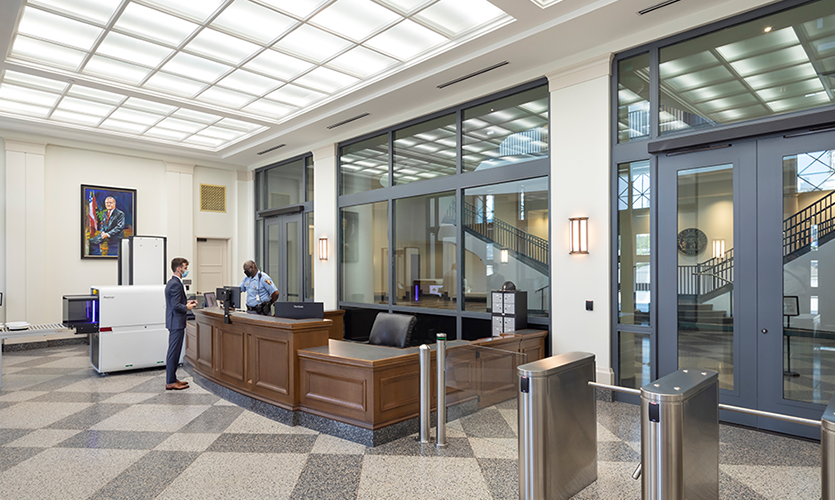Nathan Deal Judicial Center
Georgia State Financing and Investment Commission

Projects > Nathan Deal Judicial Center
Georgia State Financing and Investment Commission
Design Award:
Precast / Prestressed Concrete Institute | Design Awards: Government and Public Honorable Mention | 2021
The State of Georgia’s Nathan Deal Judicial Center is the first state-building in the history of Georgia devoted entirely to the judiciary. The seven-story, 224,500 SF facility houses the Supreme Court of Georgia, the Georgia Court of Appeals, and the newly created state-wide Business Court. This significant facility was designed to complement the State Capitol Building (Edbrooke and Burnham built circa 1889) and expand the Capitol Hill District across from Capitol Avenue. SSOE partnered with Robert A.M. Stern Architects to design a facility in the classical architectural approach that symbolizes the dignity of the courts from the beginnings of the republic.
The placement and orientation of the building is directly on axis with the dome of the State Capitol Building and the curved façade responds to the prominent Capital Avenue, Memorial Drive, and 1-20, I-75 / 85 intersections. Like the Capitol’s Legislative Chamber, the building features a central atrium that is elliptical, 112-feet in height, and connects six floors. The Supreme Court and Court of Appeals Courtrooms open onto the atrium that also provides stunning views of Capitol Hill and Downtown Atlanta and beyond.
SSOE worked in partnership with the courts, the Georgia State Financing and Investment Commission (GSFIC), the Georgia Building Authority, and the Georgia State Properties Office from programming and planning, site selection, design, and construction over 10 years to complete this historic commission. Employing energy-efficient HVAC systems, LED lighting, water-saving devices, and Georgia-sourced materials including granite and marble, the facility is one of few in Georgia to achieve a three out of four Peaches in the Georgia Peach Green Building Rating System.
“This is a magnificent architectural achievement that should evoke pride in the entire state … it embodies the ideals of our courts, as well as Governor [Nathan] Deal’s deeply personal commitment to criminal justice reform and to this great state.”
Associate Justice Clarence Thomas, U.S. Supreme Court, at Nathan Deal Judicial Center Dedication Ceremony






Have a question regarding our services? Need assistance with an upcoming project? Send us an email. We look forward to hearing from you and will follow up soon.
© SSOE GROUP 1948-2025
Legal | Privacy Policy | CA Privacy Policy | Cookie Policy
Website designed and developed by
Raincastle Communications, Inc.

 Dorchester County Courthouse
Dorchester County CourthouseAutodesk Construction Cloud (ACC) is SSOE’s enterprise-wide project delivery platform. We partner with the Autodesk Product team and have research access. Use of the AI Assistant allows our design teams, owners, and general contractors the ability to query the project specifications for quality, answers, and more rapid responses to RFIs, submittals, or issues.
SSOE has developed a proof-of-concept to use an AI Agent to act as a Master Engineer and Architect trained in SSOE’s processes, best-known-methods, and trainings. Our data structure is being remodeled to enable better use of our proprietary knowledge to train the agent on the ‘SSOE way’.
SSOE is actively piloting AI Chat large language models (LLMs) or copilots that use Natural Language Processing (NLP) to streamline both design and development tasks, transforming how our teams interact with software and each other.
By integrating chat LLM engines into platforms like Revit, we’re enabling users to prompt complex actions using simple, conversational commands. In Revit, this means automating tasks such as modeling elements, cleaning up parameter data, managing annotations and dimensions, and organizing sheets—without writing scripts. These automations and quality prompts can be shared across project teams, accelerating workflows and reducing manual effort.
Similarly, our internal Software Development Community is leveraging GitHub Copilot to expedite coding tasks. Developers can generate and refine code using NLP prompts, tapping into GitHub’s extensive Repo to move faster from concept to implementation.
Together, these tools represent a shift from traditional, expert-driven scripting to intuitive, AI-assisted automation, unlocking new levels of efficiency and scalability across our projects.
We helped our client visualize and optimize façade design for occupant comfort—long before breaking ground through the use of the Autodesk Forma tool. It allows the designer to rapidly experiment with the building’s geometry and façade design to promote sustainability, prioritizing quality of spaces and comfort for end uses, especially in extreme climates (daylighting and microclimate analysis tools) at the project’s exact geographic location, using location-specific environmental data.
Discover how SSOE is using Autodesk Forma to improve sustainability outcomes for industrial projects: SSOE Group: Improving sustainability outcomes for industrial projects with Autodesk Forma.
SSOE is utilizing Microsoft Copilot Edge and M365 to significantly enhance work efficiency and accuracy across various departments. Copilot is accessible to all staff after training. Key areas of application include using it as a writing assistant, for idea generation, document summarization and generation, research assistant, excel assistant, programming code assistant, language translations, product comparison and data analysis. Use of Copilot has become part of the everyday life of SSOE employees who have identified key ways it can help them become more efficient with their daily tasks as well as more accurate in their deliverables.
Today, 100% of SSOE employees have taken the voluntary training and have access to Copilot Edge, achieving early our October 1, 2025 goal.
We found ourselves in need of a more robust tool to enhance resource forecasting and staff assignment capabilities. Instead of waiting for the perfect tool, we’re building it. SSOE’s in-house technology team has developed and piloted a tool that aims to forecast optimal staff mix and duration for new projects against existing workload to better understand capacity and manage resources efficiently. Additionally, the tool will allow teams to identify gaps to optimal staff mix.